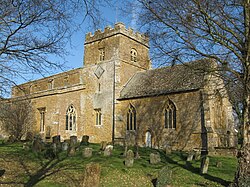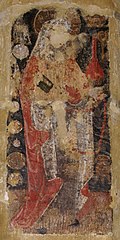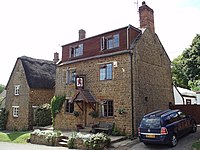Horley, Oxfordshire
| Horley | |
| Oxfordshire | |
|---|---|
 St Etheldreda's Church, Horley | |
| Location | |
| Grid reference: | SP4143 |
| Location: | 52°5’28"N, 1°23’28"W |
| Data | |
| Population: | 319 (2001) |
| Post town: | Banbury |
| Postcode: | OX15 |
| Dialling code: | 01295 |
| Local Government | |
| Council: | Cherwell |
| Parliamentary constituency: |
Banbury |
| Website: | Horley Village |
Horley is a village in the hills in the north of Oxfordshire, about 3 miles northwest of Banbury. It is a small place, with a church, one pub (the Red Lion) and a clutch of houses and cottages clustered around a ring of lanes and out to the farms beyond.
Horton is a village to the northwest, Wroxton to the south, and Hanwell to the east. The Warwickshire border is barely a quarter of a mile off beyond the fields.
Parish church
The parish church is St Etheldreda. It along with the church of St John the Baptist in Hornton were dependent chapelries of King's Sutton until the middle of the 15th century.[1]
St Etheldreda's is now one of eight parishes in the Ironstone Benefice.[2]
St. Etheldreda's is built of local Hornton stone[1] and its Norman central belltower and much of its chancel date from about 1180. Early in the 13th century the nave was replaced with one with north and south aisles and a higher roof. Early in the 14th century the chancel and both aisles were rebuilt and the south aisle and chancel were given new Decorated Gothic[3] windows.[1]
Early in the 17th century the chancel was in disrepair and the lay rector was repeatedly asked to fund repairs.[1] In 1621 the chancel was reported to be so "ruinous and much decayed" that the rain came in. In 1632 the rest of the church was alleged to be "ready to fall".[1] In the middle of the 18th century the tracery in part of the east window and two of the north windows of the chancel was replaced.[1] By 1879 St. Etheldreda's needed a thorough restoration and the vicar privately wrote that he feared for the safety of the tower, though it was not put in good order until a thorough-going restoration in 1915 by William Weir.[4][3]
Interior


St Etheldreda's interior has Mediæval wall paintings: a large and well-preserved one of St Christopher and a rare one of St Zita.[5] There are also several groups of five interlinked red rings, enclosing the letter "t", said to refer to Thomas Becket.[6]
The tower has a ring of four bells, all cast by William and Henry III Bagley[7] of Chacombe.[8] in 1706.[7]
Oxfordshire Ironstone Railway
The Oxfordshire Ironstone Railway was built during the First World War to carry ironstone from a quarry west of Horley to a junction with the Great Western Railway just north of Banbury. The ironstone railway passed just south of Horley, where a concrete bridge carried the railway over the road between Horley and Wroxton.[9] The railway was opened in 1917 and closed in 1967.
Big Society
Horley Footlights is the local amateur dramatic society. It has staged productions in the village every year since 2003.
Cricket
Outside links

| ("Wikimedia Commons" has material about Horley, Oxfordshire) |
References
- ↑ 1.0 1.1 1.2 1.3 1.4 1.5 *Lobel, Mary D; Crossley, Alan, eds (1969). A History of the County of Oxford: Volume 9. Victoria County History. pp. 123–139.
- ↑ "St Peter's Church Hanwell: The Ironstone Benefice Churches". Hanwellvillage.com. http://www.hanwellvillage.com/ironstone_benefice.htm. Retrieved 2012-06-17.
- ↑ 3.0 3.1 Sherwood, Jennifer; Pevsner, Nikolaus (1974). Oxfordshire. The Buildings of England. Harmondsworth: Penguin Books. pp. 652–653. ISBN 0-14-071045-0.
- ↑ David Goold. "Dictionary of Scottish Architects website". Scottisharchitects.org.uk. http://www.scottisharchitects.org.uk/architect_full.php?id=204049. Retrieved 2012-06-17.
- ↑ "Painted Church website". Paintedchurch.org. http://www.paintedchurch.org/horzita.htm. Retrieved 2012-06-17.
- ↑ *Walker, George Graham (1975). Churches of the Banbury Area. Kineton: Roundwood Press. p. 29. ISBN 0-900093-52-8.
- ↑ 7.0 7.1 Davies, Peter (2 March 2012). "Horley S Etheldreda". Dove's Guide for Church Bell Ringers. Central Council of Church Bell Ringers. http://dove.cccbr.org.uk/detail.php?searchString=Horley&numPerPage=10&Submit=Go&searchAmount=%3D&searchMetric=cwt&sortBy=Place&sortDir=Asc&DoveID=HORLEY+OXF. Retrieved 29 March 2012.
- ↑ Dovemaster (25 June 2006). "Bell Founders". Dove's Guide for Church Bell Ringers. Central Council of Church Bell Ringers. http://dove.cccbr.org.uk/founders.php. Retrieved 25 February 2011.
- ↑ *Tonks, Eric (April 1988). "Wroxton Quarries". The Ironstone Quarries of the Midlands. Part II The Oxfordshire Field. Cheltenham: Runpast. p. 146. ISBN 1-870754-02-6.
